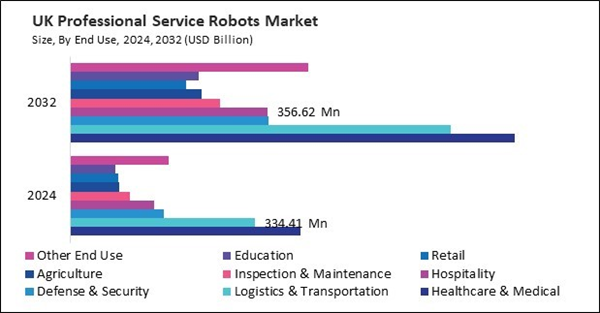The Germany market dominated the Europe Professional Service Robots Market by country in 2024, and is expected to continue to be a dominant market till 2032; thereby, achieving a market value of $4.90 billion by 2032. UK market is exhibiting a CAGR of 10.7% during 2025-2032. Additionally, the France market is expected to experience a CAGR of 12.6% during 2025-2032.
The professional service robots market has witnessed substantial growth over the past decade, driven by rapid technological advancements, a surge in demand for automation across various industries, and the growing need for solutions that can enhance productivity, precision, and safety. These robots, distinct from industrial robots typically used in manufacturing, are designed to perform useful tasks for humans or equipment, excluding industrial automation applications. With capabilities that include performing repetitive tasks, working in hazardous environments, or delivering precision services in sectors like healthcare, logistics, agriculture, and defense, professional service robots have become an essential component in the digital transformation of modern industries.
Professional service robots are extensively applied in a wide range of domains, each tailored to meet the unique needs of the industry. In the healthcare sector, service robots are used for surgery assistance, patient care, rehabilitation, and telepresence, significantly enhancing operational efficiency and patient outcomes. Robotic surgical systems enable minimally invasive procedures, reducing recovery time and minimizing human error. Mobile robots in hospitals facilitate the transportation of medications, supplies, and even meals, helping to alleviate the workload on healthcare professionals.
The market in Europe is witnessing robust growth, driven by increasing labor shortages, the need for operational efficiency, and the adoption of automation across diverse sectors. These robots are designed to perform semi- or fully autonomous tasks for commercial use outside traditional manufacturing, including in healthcare, logistics, construction, and hospitality. European countries, known for their strong engineering base and emphasis on innovation, have emerged as key contributors to the global professional service robots industry, with Germany, France, the UK, and Italy leading the charge. Initiatives like “Horizon Europe” and “Digital Europe” have further boosted R&D in robotics, emphasizing AI integration and human-machine collaboration.
The European market for professional service robots is highly competitive, with a mix of global tech giants and local startups contributing to the innovation landscape. Companies such as ABB (Switzerland), KUKA (Germany), and Blue Ocean Robotics (Denmark) are dominant players, offering advanced robotic systems tailored to healthcare, education, and logistics. Meanwhile, regional startups are developing niche robotic solutions - like eldercare robots in Scandinavia or autonomous retail robots in France - fueling localized competition. Collaborations between robotics firms and research institutions such as Fraunhofer, ETH Zurich, and Imperial College London further strengthen Europe’s competitive edge by fostering rapid prototyping and real-world testing.
List of Key Companies Profiled
- Boston Dynamics (Hyundai Motor Company)
- Cyberdyne, Inc.
- Daifuku Co., Limited
- FANUC Corporation
- Gecko Robotics, Inc.
- Honda Motor Co. Ltd.
- Intuitive Surgical, Inc.
- iRobot Corporation
- Kuka AG (Midea Group Co., Ltd.)
- SoftBank Robotics Group (SoftBank Group Corporation)
Market Report Segmentation
By Type
- Autonomous Mobile Robots (AMRs)
- Articulated Robots
- Humanoid Robots
- Unmanned Aerial Vehicles (UAVs)
- Other Type
By End Use
- Healthcare & Medical
- Logistics & Transportation
- Warehousing
- Last-Mile Delivery
- Port & Cargo Operations
- Other Logistics & Transportation Type
- Defense & Security
- Hospitality
- Inspection & Maintenance
- Agriculture
- Retail
- Education
- Other End Use
By Country
- Germany
- UK
- France
- Russia
- Spain
- Italy
- Rest of Europe
Table of Contents
Companies Mentioned
- Boston Dynamics (Hyundai Motor Company)
- Cyberdyne, Inc.
- Daifuku Co., Limited
- FANUC Corporation
- Gecko Robotics, Inc.
- Honda Motor Co. Ltd.
- Intuitive Surgical, Inc.
- iRobot Corporation
- Kuka AG (Midea Group Co., Ltd.)
- SoftBank Robotics Group (SoftBank Group Corporation)









